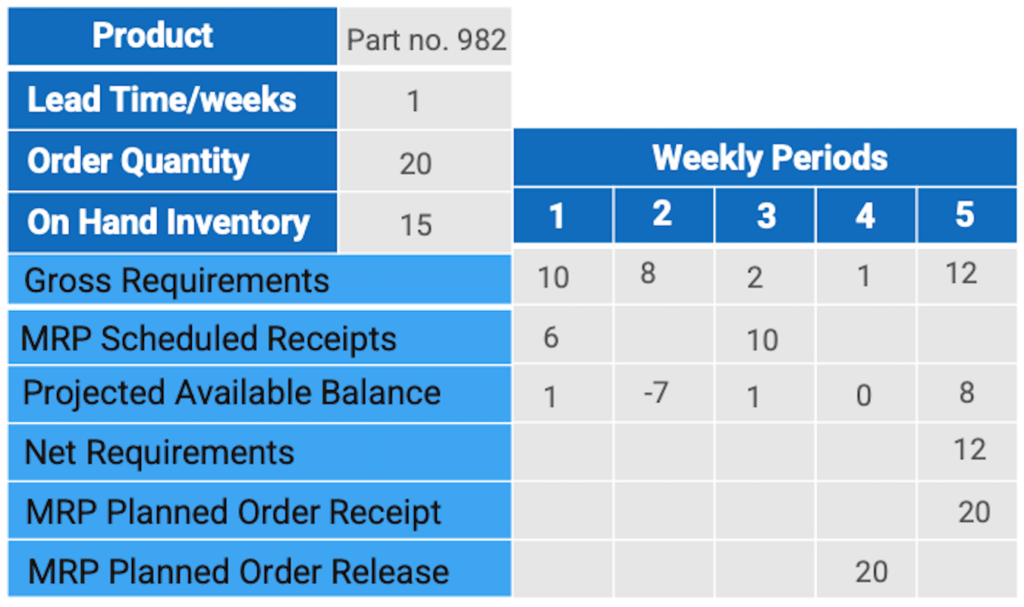To manage production inventories, planning systems offer specialized order management applications to help planners and buyers identify requirements. The first method to consider is materials requirements planning (MRP).
One common way to purchase production inventories is by utilizing the MRP application in today’s standard enterprise resource planning (ERP) system. MRP is a computerized, time-phased system that generates replenishment schedules for purchased materials, components, and assembly production. MRP determines the necessary quantities and due dates to build parent assemblies and “explodes” their bills of material, placing demand on materials and components. When demand exceeds supply for purchased items, the MRP system automatically produces planned order releases (requisitions) and action messages to synchronize supply with demand. See the image below for an example of an MRP grid.
A quick explanation of the MRP grid exhibit follows:
1. The on-hand inventory from the item master file is displayed at the top of the grid. There are 5 units on hand at the beginning of the period. Each period represents one week.
2. There is a gross requirement of 10 needed during that period. By convention, it is assumed the 10 will be needed by the end of the period.
3. In the first period, there is a scheduled receipt for 6 units. The scheduled receipt is an open order. In this case, since it is a purchased part, the open order is an open purchase order. With a gross requirement of 10, the MRP performs the math calculation of 5 plus 6 minus 10 (on hand + scheduled receipt, minus gross requirements) which is equal to a projected available balance (PAB) of 1 in the first period.
4. During period 2, there is a need for 8 units. Subtracting the previous ending point at 1 from the gross requirement of 8 gives us a new ending point of -7. (1-8= -7). As there is a scheduled receipt in period 3, the next time the MRP program runs, it will generate an action message to speed up the delivery of the scheduled receipt from period 3 to period 2.
5. In this particular MRP grid, the gross requirement for period 3 is fixed at 2, which cannot be altered. By adding the previous PAB value of -7 to the current open order of 10 and then subtracting the gross requirement of 2, we arrive at a PAB value of 1 for period 3.
6. In period 4, the gross requirement is 1. The PAB is 0 because the gross requirement will use up the 1 unit on hand.
7. During period 5, there is a gross requirement of 12 and a net requirement of 12 since the previous PAB is 0. The MRP system will utilize the lot size of 20 from the inventory master file to generate a planned order receipt for 20 in the period with the net requirement. The receipt will be adjusted by the lead time specified in the item master file, and an action message will be automatically generated for the buyer or planner to release a purchase order for 20 in period 4, which should be received in period 5.

Net Requirements – Derived as a result of applying gross requirements and allocations against inventory on hand, scheduled receipts, and safety stock. After being lot-sized and offset for lead time, net requirements become planned orders.
One of the key advantages of MRP for purchasing is that it allows users to see in advance what items and quantities are needed, along with the corresponding dates. This helps users plan deliveries in a more orderly fashion and eliminates the need for labor-intensive reviews and paperwork during the requisition process. In ERP systems, the task of organizing purchases is often streamlined through the use of order action messages and reports, with planned purchase orders guided by pre-negotiated contracts.

